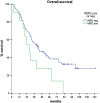HER2 Overexpression as a Poor Prognostic Determinant in Resected Biliary Tract Cancer
- PMID: 32353192
- PMCID: PMC7543291
- DOI: 10.1634/theoncologist.2019-0922
HER2 Overexpression as a Poor Prognostic Determinant in Resected Biliary Tract Cancer
Abstract
Background: HER2 overexpression has been investigated as a potential biomarker and therapeutic target in biliary tract cancer (BTC), but a prognostic role of such alteration has not been demonstrated yet.
Materials and methods: We retrospectively evaluated HER2 protein expression by immunohistochemistry (IHC) in 100 patients with radically resected BTC. HER2 gene amplification was assessed by fluorescence in situ hybridization (FISH) in 2+ and 3+ cases at IHC. High HER2 protein expression was defined as either IHC 3+ or 2+ associated with FISH positivity. The primary objective of the study was to evaluate the prognostic role of HER2 overexpression in terms of disease-free survival (DFS) and overall survival (OS). Secondary endpoints were the prevalence of HER2 overexpression and the possible correlation with other clinicopathological features.
Results: HER2 overexpression was identified in 11 patients and was not related to other clinicopathological factors. DFS was significantly shorter in HER2-positive compared with HER2-negative patients (10.6 vs. 20.9 months, log-rank p = .017). HER2 confirmed its prognostic value for DFS at multivariate analysis (hazard ratio 2.512; 95% confidence interval, 1.232-5.125; p = .011) together with nodal stage (p < .001), resection margin (p = .027), and tumor site (p = .030). There was no difference in OS between HER2-positive and -negative patients (p = .068).
Conclusion: HER2 overexpression represents an independent prognostic factor for disease recurrence in patients with BTC treated with potentially curative surgery.
Implications for practice: HER2 overexpression may play an independent role in promoting an aggressive behavior in resectable biliary tract cancer. This evidence could be helpful in improving prognostic stratification after resection and, primarily, should endorse the rationale to investigate HER2 as a therapeutic target in biliary tract cancer.
Keywords: Biliary tract cancer; Cholangiocarcinoma; Gallbladder cancer; HER2; Prognosis.
© AlphaMed Press 2020.
Conflict of interest statement
Figures



Comment in
-
Regarding "HER2 Overexpression as a Poor Prognostic Determinant in Resected Biliary Tract Cancer".Oncologist. 2020 Nov;25(11):e1818. doi: 10.1634/theoncologist.2020-0385. Epub 2020 Aug 13. Oncologist. 2020. PMID: 32715579 Free PMC article. No abstract available.
-
In Reply.Oncologist. 2020 Nov;25(11):e1819. doi: 10.1002/onco.13538. Epub 2020 Oct 3. Oncologist. 2020. PMID: 32969114 Free PMC article.
-
Limited Impact of HER2 Expression on Survival Outcomes in Patients with Intrahepatic Cholangiocarcinoma After Surgical Resection.Oncologist. 2021 Oct;26(10):e1893-e1894. doi: 10.1002/onco.13884. Epub 2021 Jul 10. Oncologist. 2021. PMID: 34176184 Free PMC article.
-
In Reply.Oncologist. 2021 Oct;26(10):e1895-e1896. doi: 10.1002/onco.13886. Epub 2021 Jul 17. Oncologist. 2021. PMID: 34176190 Free PMC article.
References
-
- Siegel RL, Miller KD, Jemal A. Cancer statistics, 2018. CA Cancer J Clin 2018;68:7–30. - PubMed
-
- Sohal DPS, Shrotriya S, Abazeed M et al. Molecular characteristics of biliary tract cancer. Crit Rev Oncol Hematol 2016;107:111–118. - PubMed
-
- Primrose JN, Fox R, Palmer DH et al. Adjuvant capecitabine for biliary tract cancer: The BILCAP randomized study. J Clin Oncol 2017;35:4006.
-
- Mavros MN, Economopoulos KP, Alexiou VG et al. Treatment and prognosis for patients with intrahepatic cholangiocarcinoma: Systematic review and meta‐analysis. JAMA Surg 2014;149:565–574. - PubMed
MeSH terms
Substances
LinkOut - more resources
Full Text Sources
Research Materials
Miscellaneous

